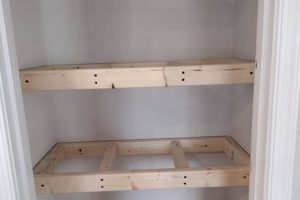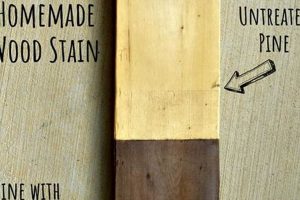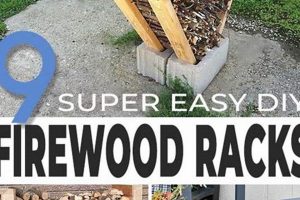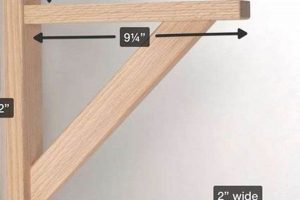Handcrafting plant containers from timber offers a customizable approach to gardening and home dcor. These constructions allow for tailored dimensions, aesthetic designs, and the potential to repurpose existing lumber. Examples range from simple, rustic boxes to more complex geometric structures, all serving the function of housing plants.
The creation of bespoke timber receptacles for flora presents several advantages. It enables precise control over drainage and soil volume, crucial for plant health. Furthermore, such projects frequently utilize reclaimed materials, promoting environmental sustainability and reducing waste. Historically, wooden planters have been employed in various cultures, reflecting local woodworking traditions and resource availability.
The following sections will elaborate on design considerations, material selection, construction techniques, and finishing options relevant to the creation of personalized plant containers. Practical guidance will be provided to facilitate successful project completion.
Essential Considerations for Timber-Based Plant Containers
Effective construction of durable and aesthetically pleasing plant receptacles necessitates careful attention to several key factors. The following provides guidance on material selection, design, and construction practices.
Tip 1: Drainage Implementation: Adequate water drainage is critical to prevent root rot and maintain plant health. Drill multiple drainage holes in the base of the container to facilitate water escape. Consider lining the interior with landscape fabric to prevent soil erosion through these openings.
Tip 2: Timber Selection: Opt for naturally rot-resistant species such as cedar, redwood, or cypress. If using treated lumber, ensure it is designated for ground contact to prevent leaching of chemicals into the soil. Untreated pine requires protective sealing to extend its lifespan.
Tip 3: Joint Construction: Employ robust joinery techniques such as dovetails, mortise and tenon, or reinforced butt joints. Exterior-grade wood glue and weather-resistant screws are essential for secure assembly. Pre-drilling screw holes prevents wood splitting.
Tip 4: Sealing and Protection: Apply a sealant or preservative specifically formulated for exterior wood applications. This will protect against moisture penetration, ultraviolet damage, and fungal growth. Consider multiple coats for enhanced durability. Ensure any product used is safe for plant environments.
Tip 5: Size and Proportion: Choose dimensions appropriate for the intended plant species and location. Overly large containers may retain excessive moisture, while undersized containers may restrict root growth. Ensure the container’s proportions complement the surrounding environment.
Tip 6: Liner Installation: Incorporate a plastic liner to further protect the wood from constant moisture exposure. The liner should extend slightly above the soil line. Puncture the liner at drainage points to allow water to escape.
Tip 7: Elevated Base: Construct an elevated base or feet to promote air circulation beneath the container. This reduces the risk of moisture buildup and prolongs the lifespan of the timber. Consider the weight distribution and stability of the base design.
Adherence to these guidelines promotes the creation of aesthetically pleasing and functionally sound timber-based planting solutions. Proper drainage, durable materials, and protective finishes are crucial for longevity and plant health.
The subsequent sections will explore specific design styles and advanced construction methods to further enhance the creative possibilities within this domain.
1. Wood Type Selection
Wood type selection is a fundamental determinant of the longevity, aesthetic, and functionality of timber-based plant containers. The characteristics inherent to different wood species directly influence the container’s resistance to decay, structural stability, and its overall suitability for horticultural applications.
- Durability and Rot Resistance
Certain wood species, such as cedar, redwood, and cypress, possess natural oils and compounds that render them highly resistant to rot, decay, and insect infestation. Utilizing these species minimizes the need for chemical treatments and extends the lifespan of the plant container, particularly in environments with high moisture levels. Conversely, less durable woods like pine require protective coatings and liners to prevent premature deterioration.
- Structural Integrity and Weight Capacity
The density and strength of the chosen wood impact the container’s ability to withstand the weight of soil, plants, and water. Hardwoods generally offer greater structural stability compared to softwoods, allowing for the construction of larger and more robust containers. Selecting a wood with adequate load-bearing capacity prevents warping, cracking, and potential collapse under sustained pressure.
- Aesthetic Considerations and Finish Compatibility
Different wood species exhibit distinct grain patterns, colors, and textures that contribute to the overall aesthetic appeal of the plant container. Some woods readily accept stains, paints, and sealants, allowing for customization and protection against the elements. The choice of wood should align with the desired aesthetic style and the intended finishing treatments to achieve a cohesive and visually pleasing result.
- Environmental Impact and Sustainability
The sourcing of wood materials impacts the environmental footprint of the plant container. Utilizing reclaimed lumber, sustainably harvested wood, or certified wood products promotes responsible forestry practices and reduces the demand for virgin timber. Choosing locally sourced wood minimizes transportation costs and supports local economies.
The selection of an appropriate wood species is crucial for the successful construction of timber-based plant receptacles. By considering factors such as durability, structural integrity, aesthetics, and environmental impact, a builder can create a container that is both functional and visually appealing, providing a suitable environment for plant growth while minimizing its impact on the planet.
2. Drainage System Design
The longevity and health of plants housed within a timber-constructed container are directly correlated with the efficacy of the drainage system incorporated into its design. Inadequate drainage results in waterlogged soil, leading to anaerobic conditions detrimental to root systems. Root rot, fungal diseases, and nutrient deficiencies manifest rapidly in such environments, compromising plant vitality and potentially leading to plant death. A functional drainage system within a wooden plant container serves as a critical component, mitigating these risks by facilitating the removal of excess water. For instance, a simple design employing drilled holes in the base of the structure, coupled with a layer of gravel at the bottom, can significantly improve drainage efficiency. The gravel layer prevents soil from clogging the drainage holes, ensuring continued water outflow.
The effectiveness of a drainage system is contingent upon several factors, including the size and number of drainage holes, the type of soil used, and the overall climate. Larger containers typically require more extensive drainage solutions to accommodate the increased volume of soil and water. Similarly, heavier soils with high clay content necessitate more robust drainage systems compared to lighter, sandier soils. In regions with frequent rainfall, enhanced drainage features, such as elevated container bases and permeable liners, become crucial for preventing water accumulation. Failure to consider these factors can render a drainage system ineffective, negating its intended benefits.
In summary, drainage system design constitutes a non-negotiable aspect of constructing timber-based plant containers. Its role in maintaining optimal soil moisture levels and preventing root-related diseases cannot be overstated. A thorough understanding of soil properties, climatic conditions, and plant-specific requirements is essential for creating a drainage system that promotes plant health and extends the lifespan of the container itself. Ignoring this critical element can lead to costly plant replacements and premature deterioration of the wooden structure, underscoring the practical significance of informed drainage system design.
3. Joint Strength Maximization
The durability and structural integrity of a timber-constructed plant container are fundamentally dependent on the strength of its joints. Maximizing joint strength directly correlates to the container’s ability to withstand the stresses imposed by soil weight, moisture exposure, and external forces. Weak or poorly executed joints inevitably lead to structural failure, resulting in warping, cracking, or complete collapse of the container. Consider a simple box joint compared to a dovetail joint; the dovetail, with its interlocking design, inherently provides a greater surface area for adhesive bonding and mechanical interlock, resulting in a significantly stronger union capable of enduring greater loads.
Effective joint strength maximization involves careful consideration of several factors, including the choice of joint type, the selection of appropriate adhesives and fasteners, and the precision of the joinery. Different joint types, such as mortise and tenon, dovetail, or lap joints, offer varying degrees of strength and complexity. The selection should be based on the anticipated load, aesthetic requirements, and the skill level of the builder. Using exterior-grade wood glue and corrosion-resistant screws or nails further enhances joint integrity by providing additional bonding and mechanical reinforcement. Precision in cutting and assembling the joints ensures tight fits and optimal load distribution, minimizing stress concentrations that can lead to premature failure. As an example, a mitered corner, while aesthetically pleasing, is inherently weaker than a box joint unless reinforced with splines or other strengthening techniques.
In summary, prioritizing joint strength maximization is paramount in the construction of durable and long-lasting wooden plant containers. Choosing appropriate joint types, employing quality adhesives and fasteners, and executing precise joinery techniques are essential for creating structures that can withstand the rigors of outdoor use. Neglecting these aspects compromises the container’s integrity, leading to premature failure and rendering the overall project unsustainable. A robustly constructed container, born of careful attention to joint strength, provides a stable and secure environment for plant growth and contributes to the overall aesthetic of the surrounding space.
4. Protective Finish Application
The longevity of a “diy wood flower pot” is inextricably linked to the application of a suitable protective finish. Unprotected timber is susceptible to degradation from moisture, ultraviolet radiation, fungal growth, and insect infestation. These elements contribute to warping, cracking, rot, and eventual structural failure. A protective finish acts as a barrier, mitigating these destructive processes and extending the service life of the plant container. For instance, a flower pot constructed from untreated pine, if exposed to the elements, may only last a season or two. In contrast, the same container treated with a quality exterior-grade sealant could potentially endure for many years.
Protective finish application for “diy wood flower pot” is not merely a cosmetic consideration; it is a functional imperative. Selection of the appropriate finish necessitates careful evaluation of environmental factors and the characteristics of the wood itself. Oil-based finishes penetrate the wood, providing water resistance and highlighting the natural grain. Water-based finishes offer excellent ultraviolet protection and are often preferred for their low volatile organic compound (VOC) content. Film-forming finishes, such as varnishes and polyurethanes, create a durable, abrasion-resistant surface but may require periodic maintenance to prevent cracking and peeling. A poorly chosen or improperly applied finish can be worse than no finish at all, trapping moisture and accelerating decay. Proper preparation of the wood surface, including sanding and cleaning, is crucial for ensuring adequate adhesion and optimal performance of the finish.
In summary, the protective finish application is an indispensable component in the construction of a durable “diy wood flower pot”. It serves as a critical defense against environmental degradation, significantly extending the container’s lifespan. Careful selection and proper application of the finish are essential for achieving optimal protection and preserving the structural integrity and aesthetic appeal of the wooden plant container. This understanding is practically significant, as it enables builders to create durable and sustainable planting solutions that withstand the rigors of outdoor use.
5. Dimensional Accuracy
Dimensional accuracy, in the context of plant container construction, signifies adherence to specified measurements and tolerances throughout the fabrication process. It is a critical determinant of structural integrity, aesthetic appeal, and overall functionality of the finished product.
- Structural Stability
Precise dimensions ensure proper alignment of component pieces, facilitating secure and stable joints. Inaccurate cuts or measurements introduce gaps and stress points, weakening the structure and increasing the risk of failure under load. For example, a planter box with uneven sides is prone to warping and eventual collapse due to unequal distribution of soil weight.
- Water Retention
Dimensional accuracy contributes to consistent wall and base construction, minimizing gaps that could lead to water leakage. Excessive water loss compromises soil moisture levels, negatively impacting plant health and requiring more frequent irrigation. Consider a container with a poorly fitted base; water will drain excessively, potentially damaging surrounding surfaces and creating an unsuitable environment for plant growth.
- Aesthetic Harmony
Accurate dimensions are essential for achieving a visually pleasing and balanced design. Uniform shapes and proportions enhance the aesthetic appeal of the planter, contributing to a cohesive and professional finish. A flower pot with skewed angles or inconsistent panel sizes detracts from its visual quality and may appear amateurish.
- Material Optimization
Precise measurements minimize material waste, reducing overall project costs and promoting environmentally responsible practices. Accurate cutting and assembly reduce the need for rework and adjustments, optimizing material usage and improving efficiency. For instance, careful planning and execution of cuts can minimize scrap wood, reducing the economic and environmental impact of the project.
The aspects outlined above highlight the importance of dimensional accuracy in the creation of durable, functional, and aesthetically pleasing “diy wood flower pot”. By attending to precise measurements and tolerances, one can ensure a successful project that effectively supports plant growth and enhances its surroundings.
Frequently Asked Questions Regarding Timber Plant Containers
The following section addresses common inquiries pertaining to the construction and maintenance of plant receptacles crafted from wood. These answers aim to provide clarity and guidance for optimal outcomes.
Question 1: Which timber species offer the greatest resistance to decay in outdoor plant container applications?
Species exhibiting natural resistance to rot, such as cedar, redwood, and cypress, are generally preferred. These woods contain inherent oils and compounds that inhibit fungal growth and insect infestation, extending the lifespan of the structure.
Question 2: What constitutes an adequate drainage system for a wooden plant receptacle?
An effective drainage system typically incorporates multiple drainage holes in the base of the container, often coupled with a layer of gravel or crushed stone to prevent soil clogging. The size and number of holes should be proportionate to the volume of the container.
Question 3: What type of adhesive is recommended for assembling wooden plant containers intended for outdoor use?
Exterior-grade wood glues specifically formulated for resistance to moisture and temperature fluctuations are essential. Polyurethane-based adhesives offer superior bonding strength and weather resistance compared to standard woodworking glues.
Question 4: How frequently should a protective finish be reapplied to a wooden plant container?
The reapplication frequency varies depending on the type of finish used and the environmental conditions. A general guideline is to inspect the finish annually and reapply as needed, typically every one to three years, or when signs of wear, cracking, or peeling become evident.
Question 5: Is it necessary to line the interior of a wooden plant container with plastic?
Lining the interior with plastic is advisable, particularly when using less durable wood species or in environments with high moisture levels. The liner helps to prevent direct contact between the soil and the wood, minimizing the risk of rot and extending the container’s lifespan. Ensure drainage holes in the liner align with those in the container base.
Question 6: What precautions should be taken when using treated lumber for plant containers?
When using treated lumber, ensure it is designated for ground contact and that the treatment chemicals are approved for use in horticultural applications. Allow the treated wood to weather for several weeks before planting to minimize the potential for chemical leaching into the soil. Consider lining the container as an added precaution.
These answers offer a foundational understanding of critical considerations in working with wooden planters. By addressing these points, a more informed approach to construction and maintenance is enabled.
The following section will delve into advanced construction methods and aesthetic design considerations.
diy wood flower pot
The preceding exploration has illuminated critical facets surrounding the creation of plant containers from timber. Key considerations encompass material selection, drainage system design, joint strength maximization, protective finish application, and dimensional accuracy. These elements collectively determine the longevity, structural integrity, and aesthetic value of the finished product.
Adherence to these principles facilitates the construction of sustainable and visually appealing plant containers. The informed application of these techniques fosters an enhanced horticultural environment, while simultaneously contributing to the aesthetic enrichment of the surrounding landscape. Continued refinement and responsible material sourcing will further elevate the practice of building with timber.







